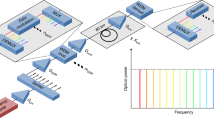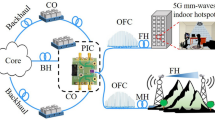Abstract
Access to the internet by mobile terminals relies on the transmission of information from the optical fibre backbone to wireless networks. Fronthaul, as the last mile of fibre-wireless convergence, determines the overall transmission performance in terms of capacity and fidelity. Orders-of-magnitude increases in both bandwidth and signal-to-noise ratio (SNR) are urgently desired to cope with the large growth in wireless traffic. Here we demonstrate a self-homodyne digital-analogue radio-over-fibre fronthaul using cloned optical frequency combs that meets these needs. The approach simultaneously supports an unprecedented 14.1 Tb s−1 common public radio interface equivalent data rate and a 1,024 quadrature-amplitude-modulated format. The clone-comb configuration, which possesses the properties of frequency and phase locking, is the key to enabling a high-performance coherent digital-analogue radio-over-fibre system. Besides exploiting the quadruple capacity for a single channel thanks to coherent detection, the clone-comb approach can also provide multiple parallel channels concurrently, boosting the overall data throughput. We further demonstrate the potential of the technique, showing its ability to transmit 65,536 quadrature-amplitude-modulated signals and a data rate of 32.8 Tb s−1. Our architecture is promising for fibre-based and free-space optical fronthaul, bringing full-band and coherent-lite access networks into reach.
This is a preview of subscription content, access via your institution
Access options
Access Nature and 54 other Nature Portfolio journals
Get Nature+, our best-value online-access subscription
$29.99 / 30 days
cancel any time
Subscribe to this journal
Receive 12 print issues and online access
$209.00 per year
only $17.42 per issue
Buy this article
- Purchase on Springer Link
- Instant access to full article PDF
Prices may be subject to local taxes which are calculated during checkout






Similar content being viewed by others
Data availability
The data that support the plots within this paper and other findings of this study are available on Zenodo (https://doi.org/10.5281/zenodo.8062271). All other data used in this study are available from the corresponding authors on reasonable request.
Code availability
The codes that support the findings of this study are available from the corresponding authors on reasonable request.
References
Peng, M., Wang, C., Lau, V. & Poor, H. V. Fronthaul-constrained cloud radio access networks: insights and challenges. IEEE Wireless Commun. 22, 152–160 (2015).
Liu, X. Enabling optical network technologies for 5G and beyond. J. Lightwave Technol. 40, 358–367 (2022).
Pizzinat, A., Chanclou, P., Saliou, F. & Diallo, T. Things you should know about fronthaul. J. Lightwave Technol. 33, 1077–1083 (2015).
CPRI Specification, V6.1. Common Public Radio Interface (CPRI); Interface Specification (CPRI, 2013).
eCPRI Specification, V2.0. Common Public Radio Interface: eCPRI Interface Specification (CPRI, 2019).
Chen, S. et al. Vision, requirements, and technology trend of 6G: how to tackle the challenges of system coverage, capacity, user data-rate and movement speed. IEEE Wireless Commun. 27, 218–228 (2020).
Che, D. Digital SNR adaptation of analog radio-over-fiber links carrying up to 1048576-QAM signals. In 2020 European Conference on Optical Communications (ECOC) Th3B.1 (IEEE, 2020).
Ishimura, S., Bekkali, A., Tanaka, K., Nishimura, K. & Suzuki, M. 1.032-Tb/s CPRI-equivalent rate IF-over-fiber transmission using a parallel IM/PM transmitter for high-capacity mobile fronthaul links. J. Lightwave Technol. 36, 1478–1484 (2018).
Le, S. T., Schuh, K., Chagnon, M., Buchali, F. & Buelow, H. 1.53-Tbps CPRI-equivalent data rate transmission with Kramers–Kronig receiver for mobile fronthaul links. In 2018 European Conference on Optical Communication (ECOC) We4B.4 (IEEE, 2018).
Argyris, N. et al. A 5G mmWave fiber-wireless IFoF analog mobile fronthaul link with up to 24-Gb/s multiband wireless capacity. J. Lightwave Technol. 37, 2883–2891 (2019).
Tanaka, K. et al. 1.314-Tbit/s (576 × 380.16 − MHz 5G NR OFDM Signals) SDM/WDM/SCM-based IF-over-fiber transmission for analog mobile fronthaul. In 2022 Optical Fiber Communications Conference and Exhibition (OFC) W4C.2 (IEEE, 2022).
New radio (NR) physical layer enhancements (release 17, 3GPP TR 21.917 V1.0.0). 3GPP https://www.3gpp.org/ftp/Specs/latest/Rel-17/21_series (2022).
Che, D., Yuan, F. & Shieh, W. High-fidelity angle-modulated analog optical link. Opt. Express 24, 16320–16328 (2016).
Ishimura, S., Kao, H.-Y., Tanaka, K., Nishimura, K. & Suzuki, M. SSBI-free direct-detection system employing phase modulation for analog optical links. J. Lightwave Technol. 38, 2719–2725 (2020).
Wang, J. et al. Delta-sigma digitization and optical coherent transmission of DOCSIS 3.1 signals in hybrid fiber coax networks. J. Lightwave Technol. 36, 568–579 (2018).
Liu, X. Hybrid digital-analog radio-over-fiber (DA-RoF) modulation and demodulation achieving a SNR gain over analog RoF of >10 dB at halved spectral efficiency. In Optical Fiber Communication Conference (OFC) 2021 Tu5D.4 (IEEE, 2021).
Zhu, Y. et al. Cascaded digital–analog radio-over-fiber for efficient SNR scaling at >10 dB per extra bandwidth. Opt. Letters 47, 3836–3839 (2022).
Xu, Y. et al. Coherent digital-analog radio-over-fiber (DA-RoF) system with a CPRI-equivalent data rate beyond 1 Tb/s for fronthaul. Opt. Express 30, 29409–29420 (2022).
Hänsch, T. W. Nobel lecture: passion for precision. Rev. Modern Phys. 78, 1297 (2006).
Hall, J. L. Nobel lecture: defining and measuring optical frequencies. Rev. Modern Phys. 78, 1279 (2006).
Boulder Atomic Clock Optical Network (BACON) Collaboration. Frequency ratio measurements at 18-digit accuracy using an optical clock network. Nature 591, 564–569 (2021).
Lisdat, C. et al. A clock network for geodesy and fundamental science. Nat. Commun. 7, 12443 (2016).
Hu, H. et al. Single-source chip-based frequency comb enabling extreme parallel data transmission. Nat. Photon. 12, 469–473 (2018).
Marin-Palomo, P. et al. Microresonator-based solitons for massively parallel coherent optical communications. Nature 546, 274–279 (2017).
Corcoran, B. et al. Ultra-dense optical data transmission over standard fibre with a single chip source. Nat. Commun. 11, 2568 (2020).
Lundberg, L. et al. Frequency comb-based WDM transmission systems enabling joint signal processing. Appl. Sci. 8, 718 (2018).
Lundberg, L. et al. Phase-coherent lightwave communications with frequency combs. Nat. Commun. 11, 201 (2020).
Mazur, M. et al. 12 b/s/Hz spectral efficiency over the C-band based on comb-based superchannels. J. Lightwave Technol. 37, 411–417 (2019).
Geng, Y. et al. Coherent optical communications using coherence-cloned Kerr soliton microcombs. Nat. Commun. 13, 1070 (2022).
Mazur, M. et al. 10 Tb/s PM-64QAM self-homodyne comb-based superchannel transmission with 4% shared pilot tone overhead. J. Lightwave Technol. 36, 3176–3184 (2018).
Erkılınç, M. et al. Bidirectional wavelength-division multiplexing transmission over installed fibre using a simplified optical coherent access transceiver. Nat. Commun. 8, 1043 (2017).
Parriaux, A., Hammani, K. & Millot, G. Electro-optic frequency combs. Adv. Opt. Photon. 12, 223–287 (2020).
Wang, L. et al. Bi-directional self-homodyne transmission with MIMO-free DSP for next-generation data center interconnects. J. Lightwave Technol. 40, 6179–6189 (2022).
Zhang, L. et al. Toward terabit digital radio over fiber systems: architecture and key technologies. IEEE Commun. Mag. 57, 131–137 (2019).
Yoshida, M. et al. 10 channel WDM 80 Gbit/s/ch, 256 QAM bi-directional coherent transmission for a high capacity next-generation mobile fronthaul. J. Lightwave Technol. 39, 1289–1295 (2021).
Zhu, Y. et al. 1λ 10.5 Tb/s CPRI-equivalent rate 1024-QAM transmission via self-homodyne digital-analog radio-over-fiber architecture. In European Conference and Exhibition on Optical Communication (ECOC) 2022 Th3A.5 (IEEE, 2022).
Carlson, D. R. et al. Ultrafast electro-optic light with subcycle control. Science 361, 1358–1363 (2018).
Zhang, C. et al. Air-gap Fabry–Pérot cavity filtered 30 nm broadband electro-optic frequency combs for high-order coherent communications. Opt. Lett. 47, 3724–3727 (2022).
Zhang, M. et al. Broadband electro-optic frequency comb generation in a lithium niobate microring resonator. Nature 568, 373–377 (2019).
Zhang, C. et al. Large-scale true-time-delay remote beamforming with EO frequency combs and multicore fiber. Opt. Lett. 46, 3793–3796 (2021).
Ji, H., Sun, C. & Shieh, W. Spectral efficiency comparison between analog and digital RoF for mobile fronthaul transmission link. J. Lightwave Technol. 38, 5617–5623 (2020).
Che, D. Analog vs digital radio-over-fiber: a spectral efficiency debate from the SNR perspective. J. Lightwave Technol. 39, 5325–5335 (2021).
Nejad, R. M. et al. RoF data transmission using four linearly polarized vector modes of a polarization maintaining elliptical ring core fiber. J. Lightwave Technol. 36, 3794–3801 (2018).
Yu, M. et al. Integrated femtosecond pulse generator on thin-film lithium niobate. Nature 612, 252–258 (2022).
Stern, B., Ji, X., Okawachi, Y., Gaeta, A. L. & Lipson, M. Battery-operated integrated frequency comb generator. Nature 562, 401–405 (2018).
Liu, Y. et al. A photonic integrated circuit–based erbium-doped amplifier. Science 376, 1309–1313 (2022).
Acknowledgements
This work is funded by National Key R&D Program of China (grant no. 2019YFB2203702 to X.X., 2022YFB2903500 to Q.Z. and 2018YFB2201704 to Weiwei Hu) by National Natural Science Foundation of China (grant no. 62071010 to X.X. and 62271305 to Weisheng Hu).
Author information
Authors and Affiliations
Contributions
C.Z., Y.Z. and X.X. jointly designed the experimental set-up. Y.Z. provided the initial basis for DA-RoF technique and digital processing methods. C.Z., B.H. and X.X. provided the initial basis for comb clone technique. C.Z. performed the experiment and analysed the results. C.Z., Y.Z., J.L. and X.X. wrote the manuscript. All co-authors contributed by providing their valuable feedback and comments. X.X. supervised the work.
Corresponding authors
Ethics declarations
Competing interests
The authors declare no competing interests.
Peer review
Peer review information
Nature Photonics thanks Giovanni Tartarini, Yongsheng Gao, Carmen Vazquez and the other, anonymous, reviewer(s) for their contribution to the peer review of this work.
Additional information
Publisher’s note Springer Nature remains neutral with regard to jurisdictional claims in published maps and institutional affiliations.
Supplementary information
Supplementary Information
Supplementary Notes 1–8.
Rights and permissions
Springer Nature or its licensor (e.g. a society or other partner) holds exclusive rights to this article under a publishing agreement with the author(s) or other rightsholder(s); author self-archiving of the accepted manuscript version of this article is solely governed by the terms of such publishing agreement and applicable law.
About this article
Cite this article
Zhang, C., Zhu, Y., He, B. et al. Clone-comb-enabled high-capacity digital-analogue fronthaul with high-order modulation formats. Nat. Photon. 17, 1000–1008 (2023). https://doi.org/10.1038/s41566-023-01273-2
Received:
Accepted:
Published:
Issue Date:
DOI: https://doi.org/10.1038/s41566-023-01273-2



